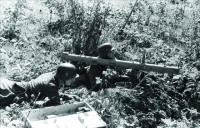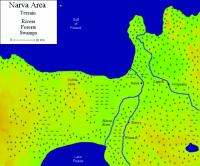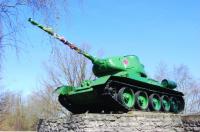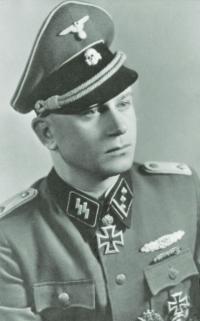THIS WEEK, 70 years ago, the Red Army finally, after six months, captured the 2500-year-old Estonian city of Narva. This was not the first time that a Russian-led army had besieged the city. The armies of Czar Ivan the Terrible captured it in 1558. After a few years it was transferred to the Swedish Kingdom. In his second attempt, Czar Peter the Great’s army captured the city in 1704, from the Swedish Kingdom.
Today, Narva has a population of 60,000 - almost 90 percent of whom are Russian - and is the third largest city in Estonia. It is located at the extreme eastern point of Estonia, on the Narva River, which drains Lake Peipus into the Gulf of Finland. The Lake and the River form the current border between Estonia and the Russian Federation. Narva is situated on the 40-mile wide isthmus which is bordered by the Lake and the Gulf of Finland.
The Germans saw Narva as the key to holding the Baltic Sea and insuring the uninterrupted flow of Swedish iron ore. Narva’s loss would also deprive Germany of the fuel derived from the Kohtla-Järve oil shale deposits 25 miles west of Narva, on the coast. Finally, as 18th Army commander, Georg Lindemann, recognized, “We are standing on the border of our native land. Every step backwards will carry the war through the air and water to Germany.”
The offensive was opened on February 2, 1944, by the Leningrad Front, under the command of Marshal Leonid Govorov. The area was defended by Army Detachment “Narwa,” commanded by General Johannes Frießner. The Detachment included the following corps: the III SS Panzerkorps, commanded by Felix Steiner; XXVI & XXXXIII Corps commanded by Anton Grasser and Karl von Oven.
SS-Obergruppenführer Steiner’s Panzerkorps consisted of the SS Nordland Panzergrenadier Division, the SS Estonian Grenadier Division, and the SS Nederlander Panzergrenadier Division. The SS Nordland, commanded by Fritz von Scholz, contained a Norwegian regiment and a Danish regiment, but it also contained Dutch, Hungarian, Finnish, French, Romanians, Spanish, Swedish, Swiss, British, and Estonian soldiers. The SS Estonian Division was commanded by Franz Augsberger and contained 15,000 Estonian soldiers. The SS Nederlander Division was commanded by Jürgen Wagner, and contained about 10,000 Dutchmen, divided into two regiments - “General Seyffardt,” named for Lt. Gen. Hendrik A. Seyffardt, who was assassinated by the Resistance on February 6, 1943, and “de Ruyter,” named for 17th century Admiral Michiel Adriaenszoon de Ruyter, commanded by Helmut Scholz.
General Grasser’s XXVI Corps included 11th, 58th and 214th Infantry Divisions commanded by Karl Burdach, Curt Siewert and Max Horn.
General von Oven’s XXXXIII Corps contained the Feldherrnhalle Panzergrenadier, 61st, 170th, & 227th Infantry Divisions, commanded by Albert Henze, Günther Krappe, Franz Griesbach, and Wilhelm Berlin
Group Narwa, also included the 1st & 2nd Latvian SS Divisions. The 1st was commanded, first by Nikolaus Heilmann until July 21, 1944, when he was transferred to the command of the 1st Ukranian SS Division. He was succeeded by Herbert von Obwurzer. The 2nd was commanded, first by Hinrich Schuldt, until he was killed in action on March 15, 1944, when he was succeeded by Bruno Streckenbach.
On February 8, 1944, the Soviets sent their peace terms to the Finns. Six days later, Stalin told Marshal Govorov that it was, “...mandatory that our forces seize Narva no later than 17 February 1944. This is required both for military, as well as political reasons. It is the most important thing right now. I demand that you undertake all necessary measures to liberate Narva, no later than the period indicated.”
Stalin’s timetable would not be met.
On March 1, 1944, the 59th Army, commanded by Lt. Gen. Ivan Kornikov, unsuccessfully assaulted an area about 15 miles southwest of Narva, defended by General Horn’s 214th Infantry Division, and two Estonian battalions. Narva, itself, was attacked by the 2nd Shock Army, commanded by Ivan Fedyuninsky, on March 8, after the VVS had dropped 3600 bombs and the artillery fired 100,000 shells into the city. It still hadn’t fallen by March 24, and General Fedyuninsky’s 2nd Shock Army was spent, having suffered 150,000 casualties. The Axis had lost about 30,000.
On July 12, 1944, General Frießner pleaded with the German Führer for permission to withdraw in order to shorten the lines. Hitler denied the request, concerned, in part, that the Finns would draw adverse inferences from any withdrawal. Unbeknownst to der Führer, General Frießner had ordered a new line - the Tannenberg - be prepared 15 miles west of Narva. Knowing that Marshal Govorov was planning to renew the assault, General Frießner, on July 21, again asked permission to withdraw to the Tannenberg Line. This time, after learning that the Finns did not consider it a problem, der Führer relented.
On the morning of July 24, the Red Army fired 17,000 shells into the defenders. This was followed by an air bombardment and an assault by the 117th and 122nd Rifle Corps, commanded by Maj. Generals Vasili Trubachev and Panteleimon Zaitsev, which was repulsed. The next morning, 280,000 shells fell on SS-Birgadeführer Augsberger’s Estonian Division, followed by an air assault. Because the Estonians had retreated to their new positions the previous evening, the 131st and 191st Rifle Corps, commanded by Maj. Generals Pyotr Romanenko and Ivan Burakovski, found them relatively intact and ready to defend their homeland.
Although Narva had been captured, on July 26, and the de Ruyter regiment destroyed, the III SS Panzerkorps, and the rest of Group Narwa, had retired to the new Tannenberg Line in relatively good order. The Wehrmacht abandoned the Tannenberg Line on September 18 and the Estonian capital of Tallinn on September 22, 1944. Shortly before the capital’s fall, the Soviet Estonian Rifle Corps, commanded by Lt. Gen. Lembit Pärn, engaged the Estonian SS. By September 26, all of Estonia was controlled by the Red Army.
It is estimated that the Red Army suffered nearly 500,000 casualties, with 100,000 dead, and the loss of 300 tanks and 230 aircraft, in its attempt to capture Narva. The cost to the Wehrmacht was 68,000 casualties, with 14,000 of them dead.
NEXT WEEK: WARSAW
Mr. Wimbrow writes from Ocean City, Maryland, where he practices law representing those persons accused of criminal and traffic offenses, and those persons who have suffered a personal injury through no fault of their own. Mr. Wimbrow can be contacted at
wimbrowlaw@gmail.com





